MENU
Starting a Business
- Best Small Business Loans
- Best Business Internet Service
- Best Online Payroll Service
- Best Business Phone Systems
Our Top Picks
- OnPay Payroll Review
- ADP Payroll Review
- Ooma Office Review
- RingCentral Review
Our In-Depth Reviews
Finance
- Best Accounting Software
- Best Merchant Services Providers
- Best Credit Card Processors
- Best Mobile Credit Card Processors
Our Top Picks
- Clover Review
- Merchant One Review
- QuickBooks Online Review
- Xero Accounting Review
Our In-Depth Reviews
- Accounting
- Finances
- Financial Solutions
- Funding
Explore More
Human Resources
- Best Human Resources Outsourcing Services
- Best Time and Attendance Software
- Best PEO Services
- Best Business Employee Retirement Plans
Our Top Picks
- Bambee Review
- Rippling HR Software Review
- TriNet Review
- Gusto Payroll Review
Our In-Depth Reviews
- Employees
- HR Solutions
- Hiring
- Managing
Explore More
Marketing and Sales
- Best Text Message Marketing Services
- Best CRM Software
- Best Email Marketing Services
- Best Website Builders
Our Top Picks
- Textedly Review
- Salesforce Review
- EZ Texting Review
- Textline Review
Our In-Depth Reviews
Technology
- Best GPS Fleet Management Software
- Best POS Systems
- Best Employee Monitoring Software
- Best Document Management Software
Our Top Picks
- Verizon Connect Fleet GPS Review
- Zoom Review
- Samsara Review
- Zoho CRM Review
Our In-Depth Reviews
Business Basics
- 4 Simple Steps to Valuing Your Small Business
- How to Write a Business Growth Plan
- 12 Business Skills You Need to Master
- How to Start a One-Person Business
Our Top Picks
Email Retargeting Campaigns and Best Practices

Table of Contents
Most people allow email marketing to affect their purchase decision-making process. Retargeting is a popular and effective marketing strategy used by e-commerce businesses to increase customer interactions and purchases. Email retargeting is successful because it is personalized, action-based and tempting to the customer.
Editor’s note: Looking for the right email marketing software for your business? Fill out the below questionnaire to have our vendor partners contact you about your needs.
What is email retargeting?
Email retargeting (also referred to as remarketing) is an easy and effective way for e-commerce businesses to use the data they previously collected on customers to personalize advertisements that compel customers to make a purchase. Obtaining this customer data is conducted with cookies, which are dropped into viewers’ browsers when they enter a site. This is the same technology that keeps shopping items in a customer’s cart when they leave and return to a website.
Retargeting uses behavioral marketing, which allows businesses to personalize their advertisements to past, current and potential buyers. Retargeting strategies focus on two main audiences: those who have purchased or shared contact information with the site and those who have visited the site without taking action. Smart marketing strategies use the information they have to refine the information they next offer their customers.
Retargeting emails can revive and catalyze brands with entirely automated marketing systems. Customers get personalized experiences that help businesses stand out from competitors and appeal to the interests of individual buyers.
How do you create a retargeting email?
Successful businesses develop retargeting strategies by employing a few best practices. These are not complex but each is essential to create an effective retargeting campaign.
Collect customer data
Top customer relationship management (CRM) technology is a necessary tool for retargeting. Tracking customer behavior with your email marketing software will allow your business to see who is active, inactive or unsubscribed from your website. Social analytics will also reveal when customers are leaving and where they are going. Businesses can make note of high-value pages, popular products, successful marketing and conversion rates.
Segment your audience
Personalization is the key to successful retargeting. The opt-in offered to a first-time visitor will differ from that for an existing customer who hasn’t returned for a while. Showing an offer meant for nonsubscribers to someone who already gets regular emails wastes a customer’s time and leaves them frustrated. That’s why when customers sign up, make a purchase or download content, it is important to remove them from the segment of potential buyers. Segmenting customers is a great way to gain people’s trust and inspire a commitment to your business.
Set campaign objectives
Successful marketing campaigns have explicit goals for their retargeting efforts. A business may want to convert casual browsers into subscribers, give new customers an incentive to make a secondary purchase or present lead magnets to those who may become subscribers. The goals should be defined through testing, with objectives based on issues identified through customer data collection and social analytics. Campaign objectives can also be determined with the help of A/B testing, which measures different versions of messaging to identify which formatting, timing and content are most effective in customer retention.
Create opt-ins and emails
The best advertisements, whether in the form of a pop-up or an email, are personal and action-oriented. People are more likely to act when directions are clear, succinct and simple. Retargeting emails should vary in content depending on the recipient. An email could offer a free gift when a customer is about to leave a site, ask for information in exchange for a free quote, remind a customer about items in their cart or direct a customer to a page sure to interest them.
The appearance, frequency and duration of retargeting messages are extremely relevant to the customer’s perception of your business. Appearing professional and legitimate helps build trust between the brand and customer. Smart marketing requires measured approaches. Customers do not want to be overwhelmed or turned off by your advertisements.
Send retargeting messages
Timing your business’s retargeting messages is as important as segmenting your audience and using social analytics to guide strategy. It is wise to send retargeting emails swiftly and with automated messaging and inbox filters, businesses can release emails immediately after a customer triggers the system with specific behavior. It is also a best practice to send a series of three retargeting emails to keep a customer’s attention. The first email of the series should always be the shortest, clearest and most impactful. The second and third emails should be content-specific and appeal to the customer’s specific interests.
This personalization and format can be automated easily with CRM technology. To send messages at the optimal time, businesses need automated messaging systems.
Successful digital marketing campaigns are also mindful of their lookback window, which is the 30-day period after a customer abandons their shopping cart. When people act, good marketing campaigns stop targeting them using bun codes, which remove the original retargeting message from the customer’s advertisements ― keeping the messages updated and personal.
What are the benefits of retargeting your emails?
There are a multitude of benefits to using retargeting. Primarily, it reduces the number of lost customers in e-commerce engagement. Retargeting is a powerful way to decrease cart abandonment, achieve better click-through rates and increase sales. This technique allows e-commerce businesses to make offers to customers who have already engaged with your business, to upsell those who showed interest in specific products and to provide personalized pop-ups depending on where the customer is in the purchasing process.
Email retargeting has the power to increase conversion rates and improve organic search rates by driving traffic to a particular page. The strategy can even be used to drive offline action and bring customers into a store. Since it is a low-cost strategy with a big upside, the return on investment from well-executed email retargeting campaigns provides ample incentive for businesses to employ it.
Email customers are committed and reliable customers. If a business is not following up on people who are not fully engaged, it will miss out on numerous sales.
When should you consider implementing a retargeting campaign?
Email marketing is one of the most effective ways for e-commerce to expand its business and retargeting is a tool that allows for strategic communication on an extremely effective platform.
It is vital for e-commerce businesses to track social analytics to identify opportunities for retargeting, so don’t begin a strategy unless you are ready to do this. Tracking customer data will reveal where a business needs to implement retargeting. Audiences can also be segmented for personalized advertisements. There are several ways retargeting can help your business.
When you have high rates of shopping cart abandonment
If a high percentage of your online shoppers abandon their carts, this impacts your e-commerce sales and bottom line negatively. Bringing visitors to your website is expensive, so it’s important that those who have browsed your site and put items in their cart but not quite made it across the finish line be given every incentive to do so. Since they have already shown a high level of interest in what you are selling, they are your best chance of making a sale.
Retargeting can help get the attention of people who have visited your site without acting, create promotions for people who have already downloaded your lead magnet and be deployed simultaneously with Facebook pixels to show ads for your products to those who have visited your site.
When you have plenty of traffic yet few conversions
When online visitors are interested in your online advertising and other website traffic-generating marketing but then leave your site without doing anything, you have a conversion gap. They may want to view competitive prices or do research before making a decision or they may simply become distracted while on your site. Making an effective call to action can be challenging if you’re not able to maintain customers’ attention.
Using a strategic follow-up plan and automated CRM technology, you can use retargeting in your digital marketing campaigns to increase conversion rates drastically.
When you want to personalize your promotions
Email marketing requires businesses to communicate with customers consistently and respectfully. Consumers also expect companies to know what they like and what they have purchased in the past. A retargeting campaign lets them know that you are paying attention, reminds them of the items that previously caught their eye and encourages them to complete their purchase through irresistible offers.
With a thorough understanding of customer behavior, personalized advertisement experiences, professional content and tactful delivery, you can utilize retargeting in a way that maximizes your business’s potential.
5 examples of companies using retargeted emails
Netflix
Streaming content companies love to personalize their messaging, providing recommendations based on previously viewed content or watchlists. In this example, the recipient received a notification email about a new season of a show they had previously seen, utilizing two immediate calls to action (CTAs) ― watch now or save for later ― doubling their chances of engagement.
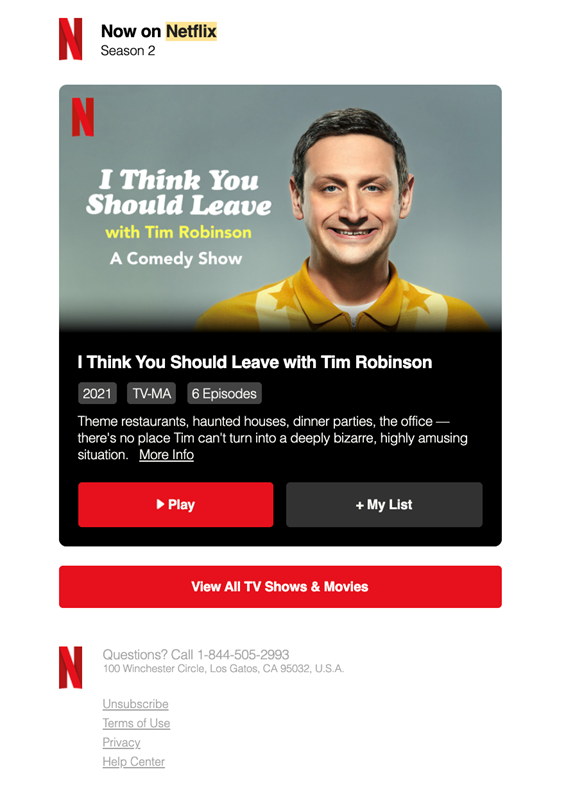
Source: Netflix
Amazon
Large online shopping outfits, such as Amazon, rely on marketing emails chock-full of product suggestions to entice previous customers to engage again. In this example, the recipient is given a showcase of stock-keeping units recommended specifically based on previous purchases or browsing history. Each item also has two CTA buttons, making conversion simple.
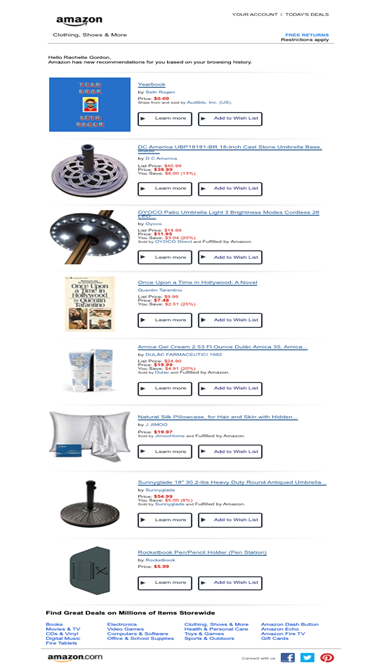
Source: Amazon
Savage X Fenty
Sending retargeted emails triggered by website clicks or abandoned carts is a great way for e-commerce businesses to increase sales. In this example, the recipient of the Savage X Fenty email had previously viewed the highlighted item. By inviting the customer to complete their order, the company gives a gentle nudge toward conversion.
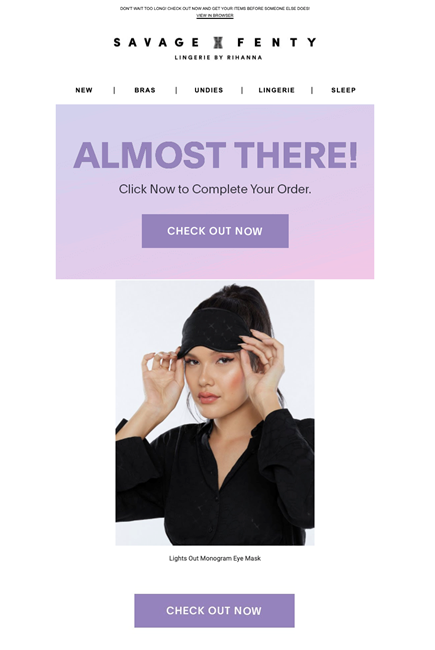
Source: Savage X Fenty
Express
In this example, clothing brand Express opts to leverage existing rewards to push engagement. A reminder that coupons that expire give a sense of urgency. Meanwhile, a counter showcasing how close the customer is to their next reward encourages a larger purchase.
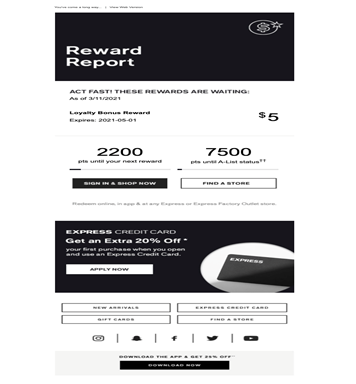
Source: Express
ModCloth
ModCloth’s triggered emails are another prime example of targeted messaging focusing on previous behavior. The email pictured reminds customers about items they previously browsed for on the website. Additional merchandise in similar styles is highlighted, likely leading to increased sales.
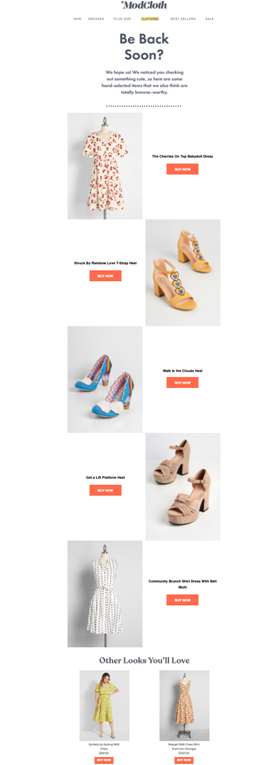
Source: ModCloth
The best email marketing software for retargeting
Email marketing programs that have integrations make it easier to create retargeting emails. We reviewed email marketing software to determine which are the best ones. Here are a few of our top email marketing software picks for retargeting.
Salesforce Marketing Cloud
If you already have Salesforce’s popular CRM software, then using Salesforce Marketing Cloud for email is a natural step. They work hand in hand and can easily produce highly personalized retargeting emails. It also integrates with ecommerce tools. Get all the details in our full Salesforce Marketing Cloud review.
Benchmark Email Marketing
Although Benchmark is a free or low-cost email marketing option, it can integrate with more than 300 applications, from Salesforce to Facebook to Shopify to Slack. This allows you to bring in your web visitors’ browsing data for retargeting. With an easy-to-use interface, Benchmark is a great choice, especially if you are starting out with email marketing. Find out more in our Benchmark Email Marketing review.
Constant Contact
Constant Contact integrates easily with multiple popular software programs. Its easy-to-use templates and editor and extensive image library make it a snap to create attractive retargeting emails that will get customers to complete their purchases. You can also use its automation capabilities to send out retargeting emails soon after a website visitor abandons an online shopping cart. Discover all of its features in our Constant Contact review.
Jennifer Dublino contributed to this article.





